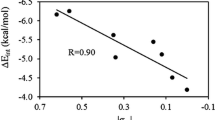Abstract
Stacking interactions of the clonidine aromatic ring with that of Phe or Tyr in the α2-adrenoreceptor and Tyr in the tetrodotoxin-resistant sodium channel pore have been studied. Ab initio quantum-chemical calculations for a model system of two parallel aromatic rings have been performed with the GAMESS software using the 6-31G* basis set in the framework of the second-order Muller-Plesset perturbation theory with full geometry optimization without symmetry constraints. The parallel shifted conformation of two aromatic rings was found to be energetically most favorable. The 2′,6′-chlorination of one of the benzene rings enhances the stacking interaction, somewhat increases the shift of these rings, and possibly improves the hypotensive and analgesic functions of clonidine owing to an increase in the binding energy. The 4-fluorination of the clonidine ring can increase its analgesic effect but practically excludes its hypotensive activity.
Similar content being viewed by others
References
P. G. Guyenet, A. J. Physiol. 273, 1580 (1997).
L. B. MacMillan, L. Hein, M. S. Smith, et al., Science 273(5276), 801 (1996).
T. Nyronen, M. Pihlavisto, et al., Mol. Pharmacol. 59(5), 1343 (2001).
J. A. Bikker, S. Trump-Kallmeyer, and C. Humblet, J. Med. Chem. 41, 2911 (1998).
T. Salminen, M. Varis, T. Nyronen, et al., J. Biol. Chem. 274(33), 23405 (1999).
J. M. Peltonen, T. Nyronen, et al., Brit. J. Pharmacol. 140, 347 (2003).
P. Bischoff and E. Kochs, Anasthesiol. Intensivmed. Notfallmed. Schmerzther. 28(1), 2 (1993).
N. Ogata and Y. Ohishi, Jpn. J. Pharmacol. 88, 365 (2002).
A. N. Akopian, V. Souslova, S. England, et al., Nature Neurosci. 2(6), 541 (1999).
F. M. Ashcroft, Ion Channels and Desease: Channelopathies (San Diego, 2000).
M. E. Brau, M. Dreimann, A. Olschewski, et al., Anesthesiology 94(1), 137 (2001).
B. Hille, Ion Channels of Excitable Membranes, 3rd ed. (Sinauer Associates, 2001).
F. Duflo, D. Conklin, X. Li, and J. C. Eisenach, Anesthesiology 93, 382 (2000).
C. Pancaro, W. Ma, M. Vincler, et al., Anesthesiology 98(3), 748 (2003).
A. I. Vislobokov and A. L. Savos’kin, Eksp. Klin. Farmakol. 2(6), 20 (1999).
I. E. Katina, G. A. Nasledov, R. S. Khrustaleva, and B. F. Shchegolev, Byull. Eksp. Biol. Med. 139(2), 166 (2005).
I. E. Katina, B. V. Krylov, R. S. Khrustaleva, et al., Byull. Eksp. Biol. Med. 139(1), 44 (2005).
Molecular Interactions, Ed. by H. Ratajczak and W. J. Orville-Thomas, (Wiley, New York, 1981; Mir, Moscow, 1984).
R. R. Ruffolo, et al., in The alpha-2 Adrenergic Receptors, Ed. by L. E. Limbird (Humana, Clifton, 1988).
V. Spirko, O. Engkvist, et al., J. Chem. Phys. 111(2), 572 (1999).
P. Hobza, H. L. Selzle, and E. W. Schlag, J. Am. Chem. Soc. 116(8), 3500 (1994).
S. Tsuzuki, T. Uchimaru, et al., J. Chem. Phys. 11(24), 11216 (2002).
R. L. Jaffe and G. D. Smith, J. Chem. Phys. 105(7), 2780 (1996).
A. D. McLean and G. S. Chadler, J. Chem. Phys. 72, 5639 (1980); R. Krishnan, J. S. Binkley, et al., J. Chem. Phys. 72, 650 (1980).
T. Clark, J. Chandrasekhar, et al., J. Comp. Chem. 4, 294 (1983).
C. Muller and M. S. Plesset, Phys. Rev. 46, 618 (1934).
J. A. Pople, R. Krishnan, et al., Int. J. Quant. Chem. XIV, 545 (1978).
K. S. Law, M. Schauer, and E. R. Bernstein, J. Chem. Phys. 81, 4871 (1984).
G. B. McGaughey, M. Gague, and A. K. Rappe, J. Biol. Chem. 273(25), 15458 (1998).
E. G. Bogdanov, D. A. Zaitsev, Yu. D. Ignatov, and A. G. Shavva, Eksp. Klin. Farmakol. 60(5), 23 (1997).
M. S. Gordon, Chem. Phys. Lett 76, 163 (1980).
M. W. Schmidt, K. K. Baldridge, J. A. Boatz, et al., J. Comput. Chem. 14(11), 1347 (1993).
R. L. Jaffe, G. D. Smith, M. E. Brau, et al., J. Chem. Phys. 105(7), 2780 (1996).
Author information
Authors and Affiliations
Corresponding author
Additional information
Original Russian Text © B.F. Shchegolev, E.V. Shlyakhto, R.S. Khrustaleva, I.E. Katina, V.A. Tsyrlin, 2007, published in Biofizika, 2007, Vol. 52, No. 6, pp. 972–977.
Rights and permissions
About this article
Cite this article
Shchegolev, B.F., Shlyakhto, E.V., Khrustaleva, R.S. et al. The role of stacking interactions in clonidine binding. BIOPHYSICS 52, 527–531 (2007). https://doi.org/10.1134/S0006350907060024
Received:
Accepted:
Published:
Issue Date:
DOI: https://doi.org/10.1134/S0006350907060024




